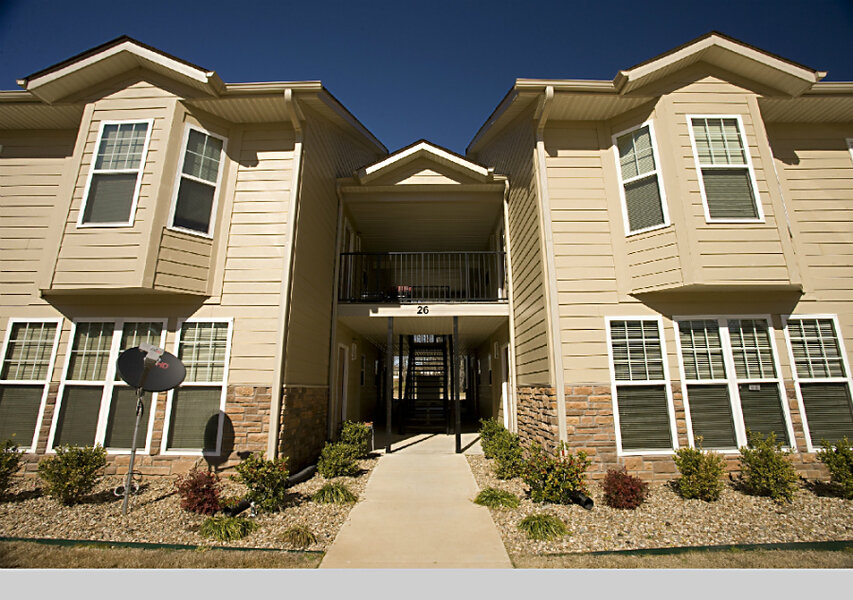Affordable housing crunch? Some investors hope to help.
Loading...
$20.30 per hour. That’s what an American worker has to earn to afford the average modest two-bedroom apartment and not pay more than 30 percent of his income on rent and utilities, according to a new survey released May 25.
That’s nearly three times the federal minimum wage, which means the worker earning the minimum would have to work 16 hours a day, every day of the year, to be able to afford that two-bedroom apartment without rent becoming onerous.
“If someone is sleeping eight hours a night, they only have time to work or sleep – and that would be it,” says Andrew Aurand, vice president for research at the National Low Income Housing Coalition (NLIHC), which produced the survey.
In reality, some 1 in 4 poor Americans get subsidies for housing, while the rest find other arrangements, sometimes paying 60 percent or more of their income to pay the rent.
And many cities are much more expensive than the national average. Seattle has one of the highest minimum wages in the nation, but even a modest one-bedroom apartment there would require twice that $13-an-hour minimum to keep housing costs under 30 percent of their income.
So housing affordability is not a problem limited to low-income families. With demand for rental housing at its highest level since the 1960s and rents rising at their fastest pace in three decades, even the middle class is feeling the squeeze in high growth cities.
“It is starting to be recognized as a problem,” says Stockton Williams, an affordable housing researcher at the Urban Land Institute, a Washington-based think tank. “The data is overwhelmingly conclusive that for many, many people in the middle, housing costs are an increasing and unsustainable burden.”
Tackling this broadening problem calls for a mix of public-private solutions, housing experts say. Already, in addition to government-run housing projects, the federal government targets subsidies to developers to build affordable housing and to landlords to offer it to the poor. Public housing advocates like NLIHC are pushing for government solutions, such as more federal funding as well as a boost in the minimum wage. Other groups, however, argue that the private sector can play a bigger role by providing a new stream of funding for public housing.
“We can't grant our way out of these problems,” says Eileen Neely, director of capital innovation at Living Cities, a New York-based nonprofit that links foundations and private capital to boost opportunity for low-income people in cities. “We really need to strategically use grants to attract private capital to help solve the problems we care about.”
In 2012, realizing it had a $26 billion backlog in public housing renovation needs, the Obama administration decided to try to use private capital to meet the public need. It launched the Rental Assistance Demonstration (RAD) program, which allows developers to take over and renovate the units as long as they continue to offer it as affordable housing.
“Because of that, we will have 185,000 public housing units that get renovated that otherwise probably would not,” says Julián Castro, secretary of the Department of Housing and Urban Development (HUD). “We just can't meet the need without effective private-sector involvement.”
The public housing isn’t really privatized, because the government still has a substantial stake in the properties. Still, RAD is attracting many private investors – especially “social impact investors” who see their mission as earning a return while meeting a social need.
Some of them are now looking beyond the poor to address the emerging middle-class woes.
The Turner Multifamily Impact Fund, for example, aims to help urban households earning up to 80 percent of the area median income by buying and managing up to $1 billion of affordable apartment communities in the US. The fund was formed in 2015 through a collaboration of real estate investment firm Turner Impact Capital, Citi Community Capital, the University of Michigan’s endowment, and the Rockefeller Brothers Fund.
Avanath Capital Management, another real estate investment firm, is acquiring similar rent-controlled or federally financed developments, with the goal of generating cash-on-cash returns of 6 to 10 percent for its investors.
Advocates of low-income housing worry that the number of heavily subsidized units for the very poor will diminish as the private sector might seek to convert properties to market-rate housing, wrote Susan Popkin, a senior fellow at the Urban Institute, in testimony to a House subcommittee hearing earlier this month. [Editor's note: The wording of this paragraph was changed to "private sector" to include a broader mix of industries.]
It’s a “very well-founded suspicion,” says James Hanlon, a geography professor at Southern Illinois University at Edwardsville. Previous programs using private developers in this way allowed them to reduce the total number of affordable housing units and rescreen the existing tenants, which forced some people to move out.
HUD has addressed those problems in RAD, he adds, and Congress has shown its willingness to fund the program. But concerns remain.
“The test for RAD is the policy environment 15 to 20 years from now when the contracts come up for renewal,” says Professor Hanlon. Will Congress still be amenable?






